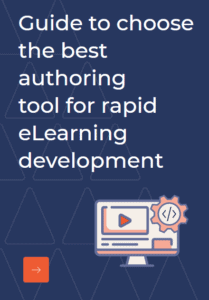Almost half a year has gone by and individuals, organizations, families, institutes, and mankind as a whole has been finding ways to adapt to a situation that had never been foreseen. Speculated about? Yes, but not taken seriously enough to be prepared for, yet, we continue to endure and live.
Stop. Step Back. Evaluate. Re-model. Accelerate.
This is the main lesson that pandemic gives us. For organizations across the globe, this has been an opportune time to rethink their operational strategies as well as an opening to re-evaluate the eLearning Development Strategy to best suit the need of the learners. For any such organization rethinking and re-evaluating, here are some key tips that can assist in the process. Here are the Key Tips for Re-Evaluating Your eLearning Development Strategy in Wake of Pandemic.
Step 1: Target the Right Questions
Evaluation requires some sort of checklist or a standard to be compared with. A checklist works well as an audit mechanism to understand how much has changed from the time eLearning was first introduced (considering that there already is a legacy system in use). Here are the questions you must ask.
- What is your organization’s learning culture? Has it changed?
- Who is your audience? Has the demographic changed?
- What are the core competencies?
- Are there various levels of competencies?
- Does the current learning model have learning paths based on the competencies?
- Subject matter relevance in terms of today, tomorrow, and near future.
- How effective is the current tracking and evaluation method?
Step 2: Conduct a Survey or Ask for Feedbacks
Why you ask? Simple, eLearning is for the learners and they have already been using the existing eLearning (based on the earlier assumption). If anything, there is always a scope of improvements based on the inputs that the users provide. Re-evaluating the eLearning development strategy for organizations with an established eLearning platform can seem to be futile, however, it can help in creating a better strategy when the time for renewal or updating comes. For organizations that have not been using eLearning extensively, this allows to see how well the current strategy is working and how new models or strategies of learning can be incorporated.
Step 3: Identify the Gaps
eLearning development strategy has to evolve with the learners and so, the existing learning content, model may not always match the needs of the current learners. Take for instance the learning content created 5 years back, there will always be gaps in terms of the information as the technology and policies keep changing over the years. Similarly, the demographic trend of learners is constantly changing and hence, a simple ‘click next’ model of eLearning may no longer work.
Step 4: Re-think Collaboration
In a time where learners are devoid of real face-to-face interactions, the global workforce instructed to work from home has been using remote communications for video conferencing, group meetings, and chatting. Re-evaluation allows you to rethink collaboration. Take, for instance, Virtual Instructor-led training (VILT), which allows learners to connect remotely with the instructors and also allows them to participate in discussions, and interact through functions such as chats, surveys, polling, and other learning activities. Creating a virtual lab can allow the real-time application of software, and enable learners to practice in a pre-constructed, non-production environment. Such strategies come in as a blessing in disguise at times when testing in an actual production environment may not be feasible for everyone.
Step 5: Incorporate Something New
With the pandemic situation, there has been an evident surge in VILT, allowing virtual interactions, learning, collaboration, and discussions. There is an increased need for self-paced learning strategies, which is why re-evaluation creates an arena to incorporate something new to the eLearning development strategy. While re-evaluating, try to analyze and incorporate different methods like microlearning, gamification, digital tutorials, assessments, scenario-based learning, video-based learning, etc. that can assist in building a better and improved eLearning strategy.
Re-Evaluating Your eLearning Development Strategy in Wake of Pandemic is an essential step for organizations to gain an upper hand in terms of training. With digitalization at its peak, having an eLearning strategy is inevitable, and for organizations with legacy content and an out-of-date eLearning strategy, it is time to move on to new platforms, new-improved up-to-date content, and training models.
While most of the re-evaluation can be handled by the in-house L&D team, re-strategizing may require expert involvement. Feel free to get in touch, in case of any such requirements.



